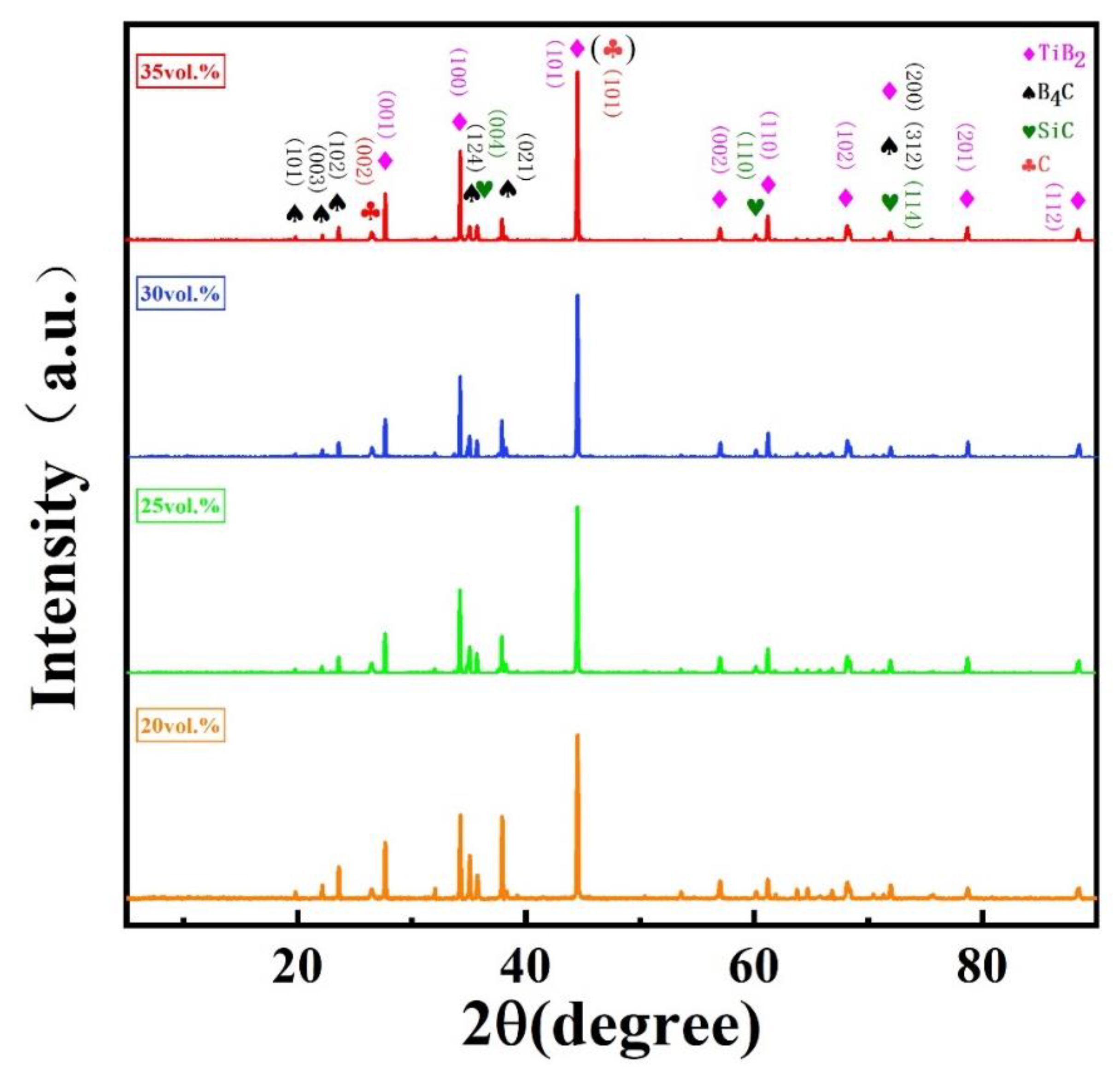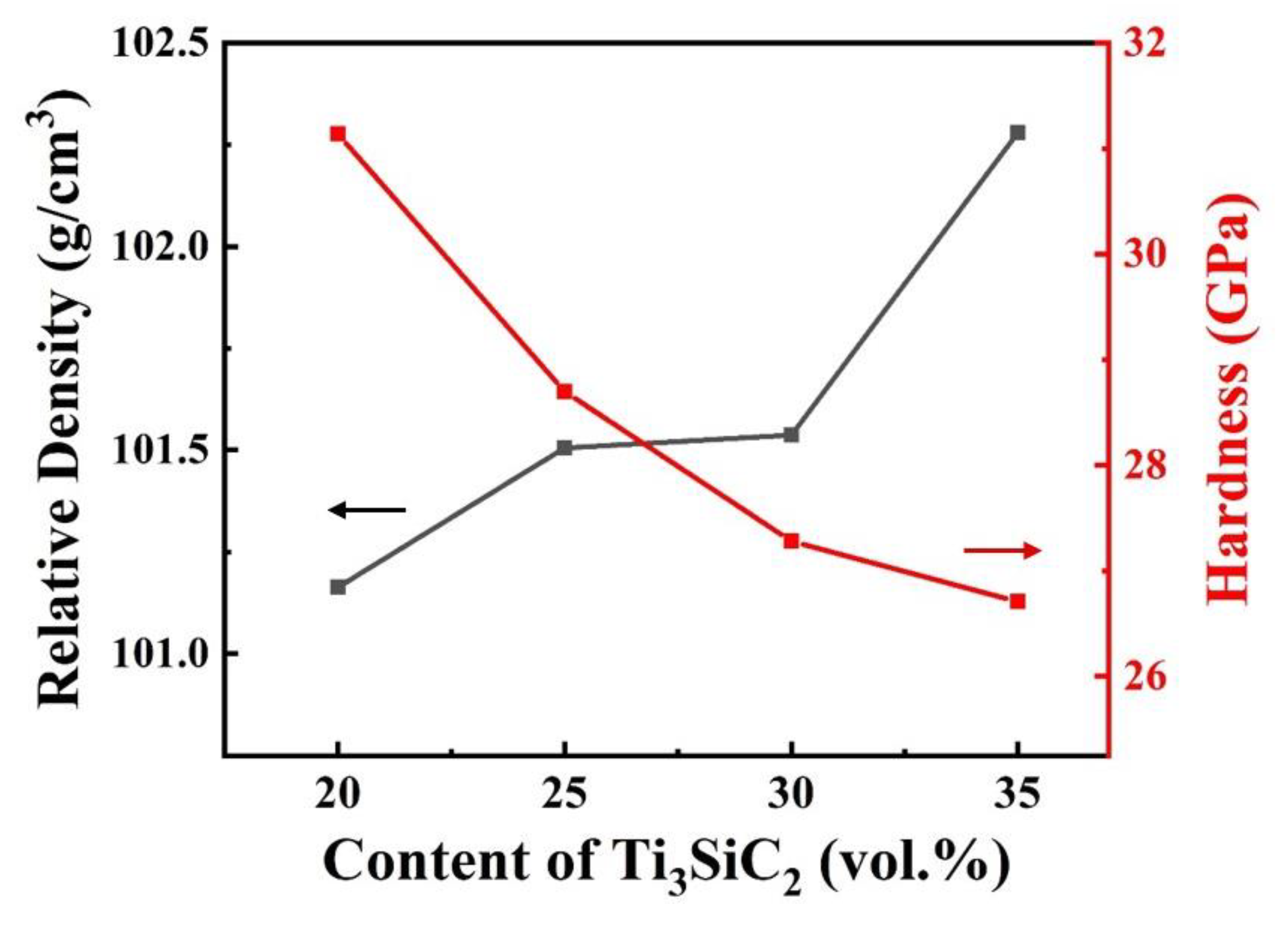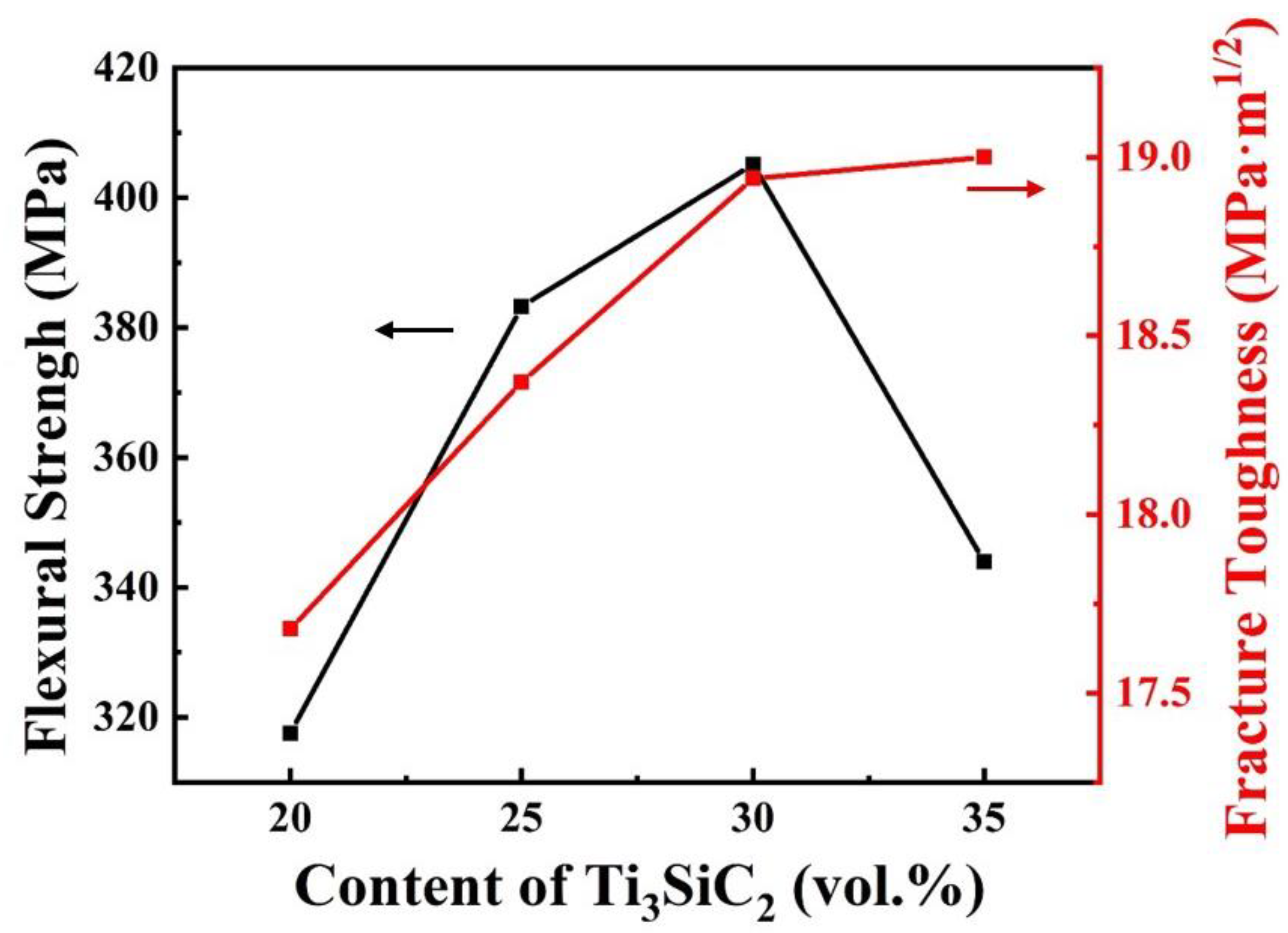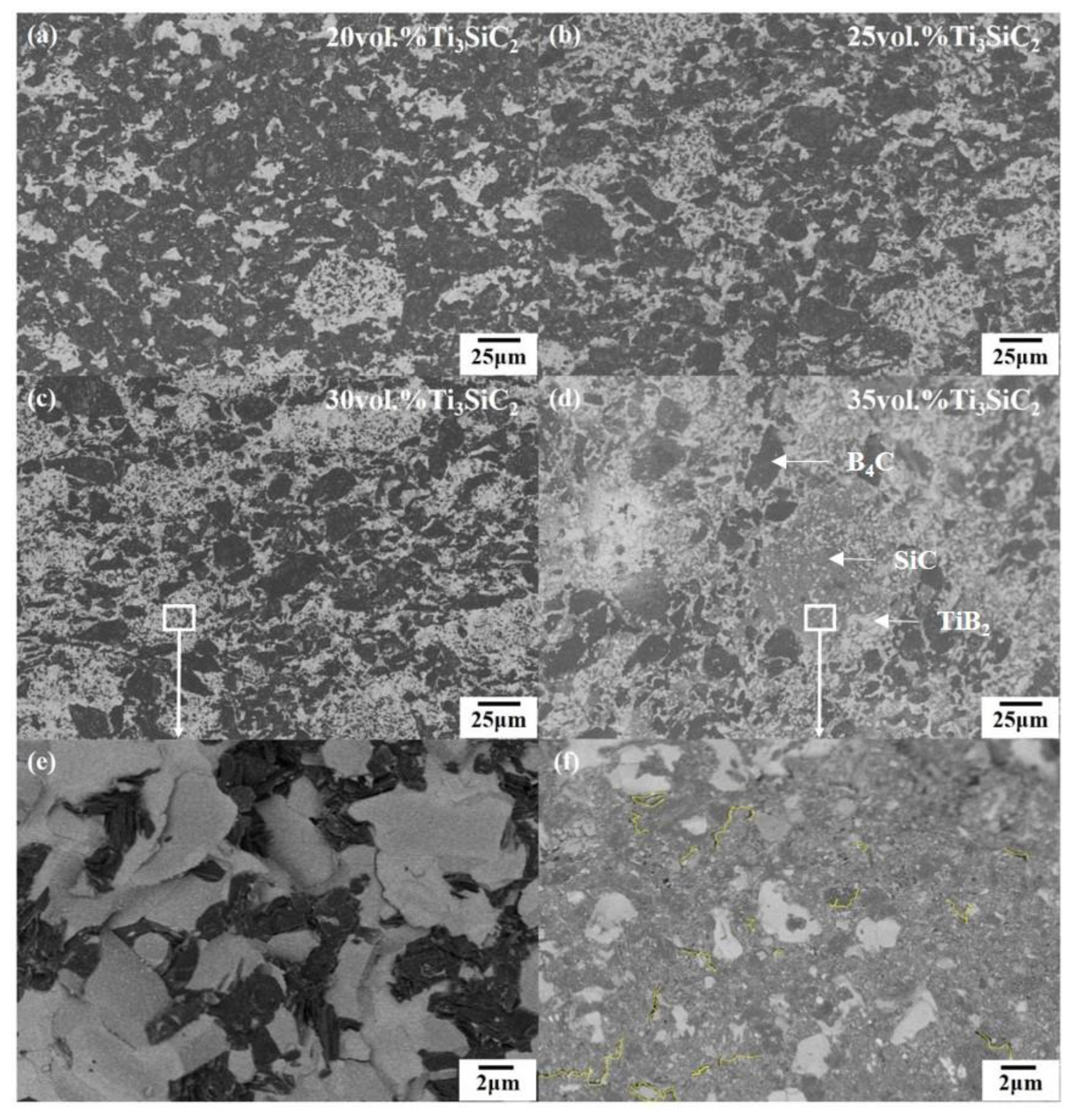Effect of Additive Ti3SiC2 Content on the Mechanical Properties of B4C–TiB2 Composites Ceramics Sintered by Spark Plasma Sintering
Abstract
:1. Introduction
2. Experimental Procedure
3. Results and Discussion
4. Conclusions
Author Contributions
Funding
Conflicts of Interest
References
- Suri, A.K.; Subramanian, C.; Sonber, J.K.; Murthy, T.S.R.C. Synthesis and consolidation of boron carbide: A review. Int. Mater. Rev. 2013, 55, 4–40. [Google Scholar] [CrossRef]
- Domnich, V.; Reynaud, S.; Haber, R.A.; Chhowalla, M. Boron Carbide: Structure, Properties, and Stability under Stress. J. Am. Ceram. Soc. 2011, 94, 3605–3628. [Google Scholar] [CrossRef]
- Ghosh, S.; Chokshi, A.H.; Lee, P.; Raj, R. A Huge Effect of Weak dc Electrical Fields on Grain Growth in Zirconia. J. Am. Ceram. Soc. 2009, 92, 1856–1859. [Google Scholar] [CrossRef]
- Zhang, Z.H.; Liu, Z.F.; Lu, J.F.; Shen, X.B.; Wang, F.C.; Wang, Y. The sintering mechanism in spark plasma sintering—Proof of the occurrence of spark discharge. Scr. Mater. 2014, 81, 56–59. [Google Scholar] [CrossRef]
- Langer, J.; Hoffmann, M.J.; Guillon, O. Direct comparison between hot pressing and electric field-assisted sintering of submicron alumina. Acta Mater. 2009, 57, 5454–5465. [Google Scholar] [CrossRef]
- Langer, J.; Hoffmann, M.J.; Guillon, O. Electric Field-Assisted Sintering in Comparison with the Hot Pressing of Yttria-Stabilized Zirconia. J. Am. Ceram. Soc. 2011, 94, 131–138. [Google Scholar] [CrossRef]
- Munir, Z.A.; Anselmi-Tamburini, U.; Ohyanagi, M. The effect of electric field and pressure on the synthesis and consolidation of materials: A review of the spark plasma sintering method. J. Mater. Sci. 2006, 41, 763–777. [Google Scholar] [CrossRef]
- Gao, H.; Asel, T.J.; Cox, J.W.; Zhang, Y.; Luo, J.; Brillson, L. Native point defect formation in flash sintered ZnO studied by depth-resolved cathodoluminescence spectroscopy. J. Appl. Phys. 2016, 120, 105302. [Google Scholar] [CrossRef]
- Wen, Q.; Tan, Y.; Zhong, Z.; Zhang, H.; Zhou, X. High toughness and electrical discharge machinable B4C-TiB2 -SiC composites fabricated at low sintering temperature. Mater. Sci. Eng. A 2017, 701, 338–343. [Google Scholar] [CrossRef]
- He, P.; Dong, S.; Kan, Y.; Zhang, X.; Ding, Y. Microstructure and mechanical properties of B4C–TiB2 composites prepared by reaction hot pressing using Ti3SiC2 as additive. Ceram. Int. 2016, 42, 650–656. [Google Scholar] [CrossRef]
- Zhang, X.; Zhang, Z.; Wang, W.; Zhang, X.; Mu, J.; Wang, G.; Fu, Z. Preparation of B4C composites toughened by TiB2-SiC agglomerates. J. Eur. Ceram. Soc. 2017, 37, 865–869. [Google Scholar] [CrossRef]
- Zhang, X.; Zhang, Z.; Liu, Y.; Wang, A.; Tian, S.; Wang, W.; Wang, J. High-performance B4C–TiB2–SiC composites with tuneable properties fabricated by reactive hot pressing. J. Eur. Ceram. Soc. 2019, 39, 2995–3002. [Google Scholar] [CrossRef]
- Zhang, Z.; Xu, C.; Du, X.; Li, Z.; Wang, J.; Xing, W.; Sheng, Y.; Wang, W.; Fu, Z. Synthesis mechanism and mechanical properties of TiB2–SiC composites fabricated with the B4C–TiC–Si system by reactive hot pressing. J. Alloys Compd. 2015, 619, 26–30. [Google Scholar] [CrossRef]
- Song, Q.; Zhang, Z.-H.; Hua, Z.-Y.; Yin, S.-P.; Wang, H.; Ma, Z.-W. Microstructure and mechanical properties of super-hard B4C ceramic fabricated by spark plasma sintering with (T3SiC2+Si) as sintering aid. Ceram. Int. 2019, 45, 8790–8797. [Google Scholar] [CrossRef]
- Yin, S.-P.; Zhang, Z.-H.; Cheng, X.-W.; Su, T.-J.; Hu, Z.-Y.; Song, Q.; Wang, H. Spark plasma sintering of B4C-TiB2-SiC composite ceramics using B4C, Ti3SiC2 and Si as starting materials. Ceram. Int. 2018, 44, 21626–21632. [Google Scholar] [CrossRef]
- Liu, Y.; Wu, X.; Liu, M.; Huang, Y.; Huang, Z. Microstructure and mechanical properties of B4C–TiB2–SiC composites fabricated by spark plasma sintering. Ceram. Int. 2020, 46, 3793–3800. [Google Scholar] [CrossRef]
- Liu, Y.; Li, Z.; Peng, Y.; Huang, Y.; Huang, Z.; Zhang, D. Effect of sintering temperature and TiB2 content on the grain size of B4C-TiB2 composites. Mater. Today Commun. 2020, 23, 100875. [Google Scholar] [CrossRef]







| Sample Name | Content of Ti3SiC2 (vol.%) | TiB2 (wt.%) | B4C (wt.%) | SiC (wt.%) | C (Graphite) (wt.%) |
|---|---|---|---|---|---|
| BT20 | 20 | 9.4 | 87.4 | 1.6 | 1.7 |
| BT25 | 25 | 19.7 | 73.2 | 3.3 | 3.8 |
| BT30 | 30 | 29.6 | 61.9 | 4.2 | 4.4 |
| BT35 | 35 | 40.6 | 47.7 | 6.1 | 5.6 |
| Simple Name | Content of Ti3SiC2 (vol.%) | Density (g/cm3) | Relative Density (%) | Hardness (GPa) | Flexural Strengh (MPa) | Fracture Toughness (MPa·m1/2) |
|---|---|---|---|---|---|---|
| BT0 | 0 | 2.50 | 99.20 | 33.50 | 224.43 | 5.96 |
| BT20 | 20 | 3.12 | 101.16 | 31.14 | 317.55 | 17.68 |
| BT25 | 25 | 3.13 | 101.51 | 28.70 | 383.25 | 18.37 |
| BT30 | 30 | 3.17 | 101.54 | 27.28 | 405.11 | 18.94 |
| BT35 | 35 | 3.17 | 102.28 | 26.71 | 343.95 | 19.00 |
| Serial No. | Starting Powder | Relative Density (%) | KIC, (MPa·m1/2) | Flexural Strength (MPa) | Ref. (Year) |
|---|---|---|---|---|---|
| 1 | B4C + 5 wt% (Ti3SiC2 + Si) | - | 5.61 | 457.6 | [14] (2019) |
| 2 | B4C + 30 wt% (TiB2 + Si) | 99.6 | 5.77 | 531.2 | [15] (2018) |
| 3 | B4C + 20 mol%TiB2 | 97.9 | 3.7 | - | [16] (2020) |
| 4 | B4C + 15 wt%SiC + 20 mol%TiB2 | 98.6 | 4.2 | 343.8 | [17] (2020) |
| 5 | B4C + 6.45 vol.%SiC + 7.78 vol.%TiB2 | 99.62 | 6.38 | 632 | [12] (2019) |
| 6 | B4C + 30 vol.% Ti3SiC2 | 98.72 | 8.0 | 492.3 | [9] (2017) |
| BT30 | B4C + 30 vol.% Ti3SiC2 | 101.54 | 18.94 | 405.11 | This work |
Publisher’s Note: MDPI stays neutral with regard to jurisdictional claims in published maps and institutional affiliations. |
© 2020 by the authors. Licensee MDPI, Basel, Switzerland. This article is an open access article distributed under the terms and conditions of the Creative Commons Attribution (CC BY) license (http://creativecommons.org/licenses/by/4.0/).
Share and Cite
Yan, X.; Zhou, X.; Wang, H. Effect of Additive Ti3SiC2 Content on the Mechanical Properties of B4C–TiB2 Composites Ceramics Sintered by Spark Plasma Sintering. Materials 2020, 13, 4616. https://doi.org/10.3390/ma13204616
Yan X, Zhou X, Wang H. Effect of Additive Ti3SiC2 Content on the Mechanical Properties of B4C–TiB2 Composites Ceramics Sintered by Spark Plasma Sintering. Materials. 2020; 13(20):4616. https://doi.org/10.3390/ma13204616
Chicago/Turabian StyleYan, Xingheng, Xingui Zhou, and Honglei Wang. 2020. "Effect of Additive Ti3SiC2 Content on the Mechanical Properties of B4C–TiB2 Composites Ceramics Sintered by Spark Plasma Sintering" Materials 13, no. 20: 4616. https://doi.org/10.3390/ma13204616
APA StyleYan, X., Zhou, X., & Wang, H. (2020). Effect of Additive Ti3SiC2 Content on the Mechanical Properties of B4C–TiB2 Composites Ceramics Sintered by Spark Plasma Sintering. Materials, 13(20), 4616. https://doi.org/10.3390/ma13204616




